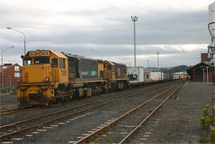 |
 |
|
| eNews • December 2010 | ||
| Promoting a Cost-Effective, Reliable and Competitive Transportation System |
||
 Soy Transportation Coalition publishes updated study on rail transportation of soybeans
Soy Transportation Coalition publishes updated study on rail transportation of soybeans
The Soy Transportation Coalition (STC) recently updated its annual report on the railroad transportation of soybeans and soy products – highlighting the significance of our nation’s railroads to the soybean industry.
The study provides statistics – both on a national and individual state level – on the volume of soybeans, soybean meal, soybean oil, and biodiesel moved by the rail industry; the leading destinations for those products; and the revenue and rates associated with those movements. As with the 2009 report, the analysis monitors the volume of soybeans and soy products transported at potentially excessive rates, those states whose soybean industry is most dependent on rail service, and those railroads that transport the highest volumes of soybeans and soy products.
Among the findings generated by the study:
- The largest Class I railroads transport 24 percent of the soybeans, 43 percent of the soybean meal, 67 percent of the soybean oil, and 99 percent of the biodiesel produced in the U.S.
- BNSF Railway transports the largest volume of soybeans – 10.7 million tons in 2009. Union Pacific Railroad is the largest originator of soybean meal (6.2 million tons) and soybean oil (2.7 million tons).
- The largest destination area for the railroad movement of soybeans continues to be the Pacific Northwest (PNW) ports in Washington and Oregon. Forty-nine percent of soybeans loaded into a rail car are destined to the PNW – underscoring the strength of the Asian export market.
- Forty-one percent of rail movements of soybeans (9.89 million tons) are transported at rates the United States Surface Transportation Board would classify as potentially excessive – resulting in a potential overcharge of $110 million in 2008. 60 percent of biodiesel is transported at potentially excessive rates.
- Revenue among the largest Class I railroads from transporting soybeans and soy products dropped 2 percent from the previous year – from $1.505 billion in 2008 to $1.477 billion in 2009. From 2006 to 2009, Class I railroad revenue increased from $1.120 billion to $1.477 billion.
- From 2008 to 2009, rail revenues on a per ton basis dropped 5 percent for soybeans, 5 percent for soybean meal, and 0.2 percent for soybean oil.
Dean Campbell, a farmer from Coulterville, Ill., and Chairman of the Soy Transportation Coalition, says, “As the STC analysis confirms, our nation’s railroads are essential to the profitability of the soybean industry, and the soybean industry is essential to the profitability of railroads. Farmers acknowledge that railroads need to generate necessary revenues to maintain and enhance their infrastructure, yet if rail transportation becomes too costly, farmer profitability and agricultural exports will be diminished. The Soy Transportation Coalition works to help promote a balanced relationship in which both farmers and the railroads can benefit.”
“The potential $110 million overcharge by the railroads underscores the need for agricultural shippers to have a more accessible rate resolution process,” explains Mike Steenhoek, executive director of the Soy Transportation Coalition. “While many rail rates are undoubtedly justified, some are not. As a result, a significant amount of money is not being retained in farmers’ wallets or in rural communities due to unreasonable rates. Creating an environment that encourages continued infrastructure investment by the rail industry yet allows disaffected shippers to efficiently seek rate relief is possible and should be the goal of everyone concerned with the future of U.S. agriculture.”
In December of 2009, the Senate Commerce, Science, and Transportation Committee passed S.2889, “The Surface Transportation Board (STB) Reauthorization Act of 2009.” The bill seeks to address a number of rail shipper concerns by increasing rail industry competition, improving federal oversight, and enhancing rail customer access to regulatory relief. The bill has yet to be considered by the full Senate. A summary of the bill can be found at: http://soytransportation.org/newsroom/STBReauthorizationSummary.pdf.
Earlier this year, the STC released its first annual Rail Customer Satisfaction Index in which leading U.S. grain and oilseed shippers ranked the nation’s largest railroads in three categories: 1.) On Time Performance; 2.) Customer Service; and 3.) Costs. BNSF Railway received the overall highest rating among the nation’s seven Class I railroads. Additional information on the index can be accessed at: http://soytransportation.org/newsroom/stc042310railcustomersatisfaction.pdf.
The full STC study on the railroad movement of soybeans and soy products can be accessed at the STC’s website: www.soytransportation.org.
Soy Transportation Coalition |
|
